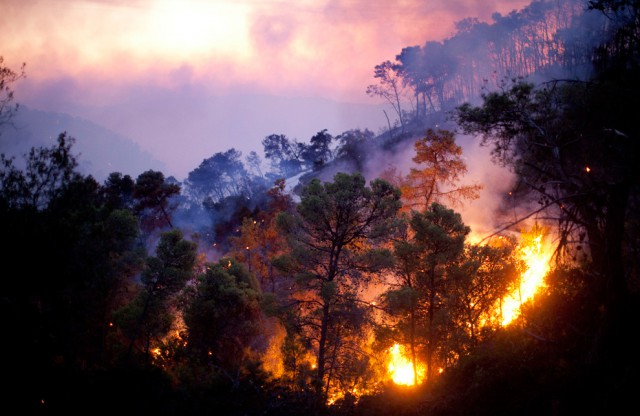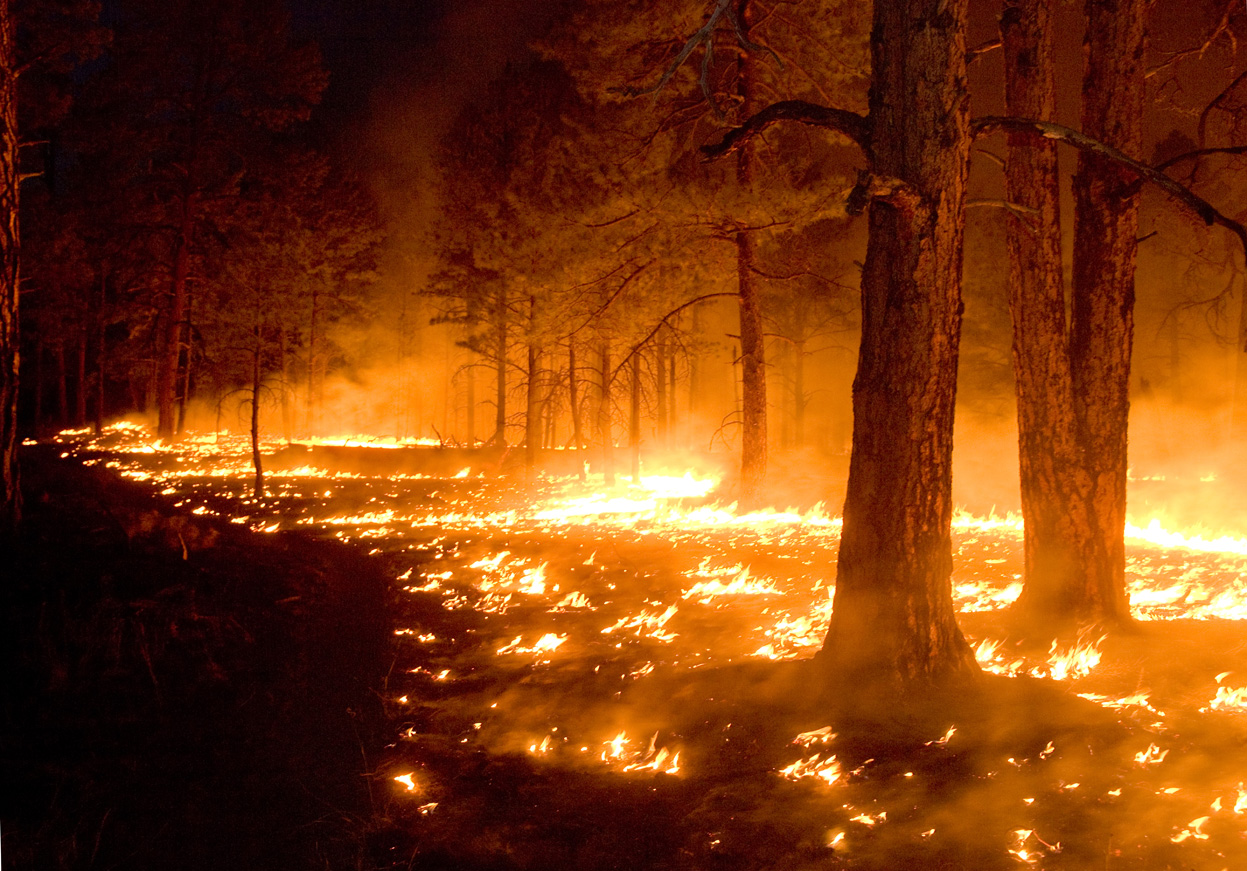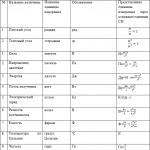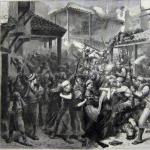Horse fire
Crown fires in clean oak forests are possible in early spring and late autumn. Crown fires are the most dangerous for both forests and people; they are usually accompanied by the death of trees of all species with thin bark, a low crown and a shallow root system. A crown fire is a relatively rare phenomenon. Most of these fires develop in inaccessible mountain forests. The only practical way to deal with them is annealing. Its effectiveness is based on the fact that a crown fire cannot spread if the crown is not heated by a ground fire. At night, crown fires in the crowns almost always stop. Raised fires can be fugitive and stable; in the latter case, the fire moves as a solid wall from the ground cover to the crowns of trees at a speed of up to 8 km/hour. Running fires occur only in strong winds; the fire spreads along the canopy in spurts at speeds of up to 25 km/h and usually outstrips the front. ground fire . Raised fires, releasing a large amount of heat, cause upward flows of combustion products and heated air and form convective columns with a diameter of several hundred meters. Their forward movement coincides with the direction of movement of the fire front. The flame in the middle of the column can rise to a height of 100 - 120 meters. The convective column increases the air flow into the fire zone and generates wind, which intensifies the combustion. Crown fires, releasing a large amount of heat, cause upward flows of combustion products and heated air and form convective columns with a diameter of several hundred meters. Their forward movement coincides with the direction of movement of the fire front. The flame in the middle of the column can rise to a height of 100 - 120 meters. The convective column increases the air flow into the fire zone and generates wind, which intensifies the combustion. Raised fires can be fugitive and stable; in the latter case, the fire moves as a solid wall from the ground cover to the crowns of trees at a speed of up to 8 km/hour. A sustained crown fire usually occurs in calm conditions and in light winds. It does not have a clearly defined front, and therefore it should be annealed from all sides. However, given that the fire can take on a running nature, the annealed strip is increased to 100 m if possible, using stepped or advanced fire to speed up the annealing. All crown fires occur during the daytime. They spread in young coniferous (pine, cedar, spruce, fir) trees, as well as in plantations of older ages with vertical crown closure, which is formed due to the diversity of plantings and undergrowth. Therefore, a crown fire may not form immediately, but some time after the bomb falls. This means that we must use this interval as much as possible to fight fires. More than once, crown fires have caused the death of entire cities and are one of the frequent causes of death of people caught in the forest, and often the death of workers taking part in extinguishing the fire. Extinguishing a forest crown fire is more difficult. During crown fires, a large amount of heat is released, the height of the flame rises by 100 m or more. Large crown fires are accompanied by intense movement of flame over considerable distances (sometimes up to several kilometers) with the formation of vortices. In cedar forests, crown fires can occur throughout the fire season. To extinguish overhead fires, two main methods are used: the method of cutting an explosive clearing and the counter-fire method. When extinguishing crown fires, more often than when eliminating other types of fire in the forest, it is necessary to rebuild work on the fly. Differences between forest pine forests and spruce dens and forest development after fires. When a crown fire occurs in spruce and spruce-fir forests, the barrier role of the streams themselves is significantly reduced. In such cases, fire can sometimes spread across rivers several tens or even hundreds of meters wide. In turn, ground and crown fires can be stable and fugitive. During a fluent crown fire, the shape of the square is elongated in the direction of the wind. The smoke from the crown fire is dark. The shape of the square during a fluent crown fire is elongated in the direction of the wind. The smoke from the crown fire is dark. In the same way, a crown fire is divided: a crown fire - a runaway one, in which the tops of trees are scorched and the trunks in the upper part are burned, and a stable crown fire (widespread), in which, according to the instructions of prof. Based on the speed of fire spread, ground and crown fires are divided into stable and fugitive. A weak ground fire spreads at a speed of no more than 1 m/min, a medium one - from 1 to 3, a strong one - over 3 m/min. A crown fire has a much higher speed: a weak crown fire is up to 3 m/min, a medium fire is up to 100, a strong fire is over 100 m/min. Since the intensity of combustion depends on the state of the supply of combustible materials, the degree of their flammability, the slope of the terrain, the time of day and especially the strength of the wind, during the same fire the speed of fire spread in a forest area can vary significantly. In turn, ground and crown fires can be stable and fugitive. During the period of exceptional development of crown fires, when the fight against fire can drag on for a week, it is necessary to carefully ensure that the workers do not become exhausted. Alternating work and rest brings significantly more benefits than prolonged exertion without rest. The completeness of the tree stand affects the rate of crown fire differently than that of ground fire: in closed forest stands, crown fire occurs continuously. air flow; in sparse forest stands its progress (if we exclude a storm wind or hurricane) is hampered and slowed down. Despite the relatively small number of crown fires, they spread over a large area and cause great harm. The most important characteristics are the speed of spread of ground and crown fires and the depth of underground burning. Therefore, they are divided into weak, medium and strong. Based on the speed of fire spread, ground and top fires are divided into stable and fugitive. The speed of spread of a weak ground fire does not exceed 1 m/min, a medium one - from 1 to 3 m/min, a strong one - over 3 m/min. A weak crown fire has a speed of up to 3 m/min, a medium one - up to 100 m/min, a strong one - over 100 m/min. According to the very course of the fire in crown fires, as experience shows, it is often more advantageous to shift the center of gravity of the fight to the night hours, when the wind speed decreases and the relative air humidity rises. At night the heat subsides and it is easier to work. This is why counter fire is usually only used at night. Daytime, especially the midday hours, are set aside for rest. When fire spreads to the crowns of plantings, crown fires occur. A ground fire, penetrating into dried peat, causes combustion of it or the humus layer. In this case, the fire engulfs the root system of trees that fall out of the soil. This type of fire, developing in a layer of peat or humus, is called soil, or underground. That is why the leader of the work on extinguishing overhead fires requires not only Suvorov’s eye, speed and pressure, but also self-control, great endurance for the most intense work, often for entire weeks. Energistically introduce the use of chemicals in the fight against crown fires, and not just with ground-level ground fires, the elimination of which is much easier. In riverine and tame spruce forests, the danger of crown fires cannot be excluded due to the transfer of fire from neighboring forest types occupying elevated, drier places; the risk of crown fires is higher the more fir and cedar there are in the forest stand, and the lower the more; deciduous: alder, birch, aspen, etc. To what was previously said regarding fir (the role of essential oils, witches' broom, etc. The proximity of conifers, especially young pine trees, creates a threat of crown fire, and two can be distinguished possible options: 1) less dangerous - when young pine trees adjoin old pine trees, but do not enter under their canopy and 2) more dangerous - when such young stands not only adjoin, but even enter under the sparse canopy, increasing the threat of the crowns and old trees catching fire. From them, the fire is transferred to the crowns of neighboring, more closed stands, and thus a crown fire is formed. We have often observed crown fires in the forests of the north with just this combination. The organization of work and the correct balance of forces acquire special importance when extinguishing crown fires, not only because of the dangers that threaten the forestry object - the forest, but also due to the serious danger for people working to extinguish such fires. When developing new effective technical means of extinguishing grassland, peat and especially crown fires, the use of conversion equipment and dual technologies is provided. To test the new forest fire equipment It is planned to build a special training ground in the city of Luga, Leningrad Region. The completeness of the forest stand affects the rate of crown fire differently than that of ground fire: in closed forest stands, crown fire proceeds as a continuous fire air flow; in sparse forest stands its progress (if we exclude a storm wind or hurricane) is hampered and slowed down. In riverine and tame spruce forests, the danger of crown fires cannot be excluded due to the transfer of fire from neighboring forest types occupying elevated, drier places; the risk of crown fires is higher the more fir and cedar there are in the forest stand, and the lower the more; deciduous: alder, birch, aspen, etc. To what was previously said in relation to fir (the role of essential oils, witches' brooms, etc. But, once they occur, fires cause much more harm here, since due to the low descent of living branches and the presence of different heights of undergrowth, any ground fire in spruce and fir forests quickly turns into a crown fire. In this case, spruce forests that survived fires in logs with moist soil can even expand the territory they occupy. Running crown fires occur both in the first and second half of the summer . During crown fires, a large amount of heat is released, the height of the flame rises by 100 m or more. Large crown fires are accompanied by intense movement of the flame over significant distances (sometimes up to several kilometers) with the formation of vortices. Forest fires are divided into ground fires, crown fires and underground, or peat fires Among crown fires it is necessary to distinguish: 1) crown fires, 2) general fires, 3 trunk fires. During a fluent crown fire, the shape of the square is elongated in the direction of the wind. The smoke from the crown fire is dark. The shape of the square during a fluent crown fire is elongated in the direction of the wind. The smoke from the crown fire is dark. Forest fires - ground fires, crown fires, subsurface fires, etc. - are dangerous natural disasters that cause enormous damage and pose a threat to people located near the areas where fires occur and spread. In a crown fire, trees burn from bottom to top; In a ground fire, dry grass, moss, lichen, and shrubs burn. A top stable fire is the next stage of a bottom fire; the flame of a bottom fire sets fire to the crowns of trees, while needles, leaves, small and larger branches burn. The tree stand after a crown fire, as a rule, dies completely, leaving only the charred remains of the trunks. In a stable top fire, the fire spreads across the crowns only as the edge of the bottom fire moves. In a running fire on top, which occurs only during a strong wind, the fire spreads along the tree crowns in jumps, ahead of the front of the ground fire. The wind also carries burning branches, other small burning objects and sparks, which create new ground fires hundreds of meters ahead of the main source. In some cases, fire is spread in this manner across rivers, wide roads, treeless areas and other apparent boundaries to localize the fire. A top stable fire is the next stage of a bottom fire; the flame of a bottom fire sets fire to the crowns of trees, while needles, leaves, small and larger branches burn. The tree stand after a crown fire, as a rule, dies completely, leaving only the charred remains of the trunks. In a stable top fire, the fire spreads along the crowns as the edge of the bottom fire moves. Risk of fires in spruce forests. In conclusion, let us remind you once again that reducing the risk of fire in spruce forests does not mean reducing the risk of destruction from it in these forests. On the contrary, there is a very high threat of the most destructive crown fires. In forests Far East, Siberia, the Urals, and the north of the European part of Russia, they patrol forests from airplanes and helicopters. In addition to detecting fires, aviation is widely used in extinguishing ground and crown fires. In Russia, more than 519.96 million hectares of forest are protected from the air. For this purpose, a network of air bases with operational air departments has been organized. The forest area protected by land-based methods is approximately 80 million hectares. The increased rate of crown fires, especially crown fires, is facilitated by the presence of ethereal and resinous substances in the needles and other parts of trees. Even in deciduous forests, but consisting of species containing essential oils, crown fires develop. Eucalyptus forests are a particularly striking example. Runaway ground fires are characterized by rapid fire progression, as dry grass and fallen leaves burn. In this case, as a rule, mature trees are not damaged, but there is a threat of a crown fire. With stable ground fires, typical of the second half of summer, the edge of the fire has a relatively low speed of advancement, but a lot of smoke is produced.
A natural disaster in which fire is almost impossible to control and spreads through forest areas is called a forest fire. Forest fires are usually divided into natural and anthropogenic. The most common fires are fires caused by lightning strikes. Forest fires are sometimes so large that they can even be seen from space. Fires caused by lightning strikes most often occur in old forests, since old trees have much more dry branches than young trees. Therefore, in young forests there are practically no fires caused by lightning. Thus, a kind of balance existed in nature long before the advent of man. Old forests burned down, and young green ones grew in their places. This was the ecological role of forest fires.
According to statistics, the share of natural forest fires in the world is 7-8% of the total number of natural fires. Most forest fires are caused by human activity. Thus, there is an urgent need to work fire services, monitoring compliance with fire safety regulations and compliance with fire safety laws.
Controlled fires are fires that are caused artificially. The purpose of such fires can be: fighting insects and forest diseases, preparing the forest for further planting seedlings, removal of logging waste, as well as deliberate arson of forests for the purpose of its subsequent cutting down.
Fires are divided into ground fires and crown fires.
At ground fire forest litter, lichens, mosses, grasses, branches that have fallen to the ground, etc. burn. The speed of such a fire in the wind is 0.25-5 km/h. The flame height reaches 2.5 m. The combustion temperature is about 700 °C (sometimes higher). Ground fires are fluent and stable: the first one burns the upper part of the ground cover, undergrowth and undergrowth. Such a fire spreads at high speed, bypassing places with high humidity, so part of the area remains unaffected by fire. The second, runaway fires mainly occur in the spring, when only the most upper layer small flammable materials. A crown forest fire covers leaves, needles, branches, and the entire crown; it can cover (in the event of a general fire) the grass-moss cover of the soil and undergrowth. Spread speed from 5-70 km/h. Temperature from 900 °C to 1200 °C. They usually develop during dry, windy weather from a ground fire in plantations with low-lying crowns, in stands of different ages, as well as with abundant coniferous undergrowth.
High hurricane fires arise due to strong wind, they are very dangerous with their enormous speed of spread, which can reach a maximum speed of 70 kilometers per hour. A general fire is dangerous because the forest burns out completely as the fire spreads vertical wall from the soil to the very tops of the trees. The speed of such a fire is approximately 8 kilometers per hour.
Crown fires are very dangerous and very difficult to extinguish, since a large number of sparks are formed at the tops of trees, which fly ahead of the main fire and form ground fires hundreds of meters ahead of the main source.
Forest fires can occur as a result of the drainage of swamps due to the combustion of peat. Such fires are called underground or soil, the speed of such fires is 1 kilometer per hour. Such fires can spread several meters deep and are therefore hardly noticeable. The difficulty of extinguishing such a fire is that peat can burn under water and without air access. Preliminary reconnaissance is needed for such forest fires.
A forest fire is the uncontrolled spread of fire through a forest area. In any situation, even a small fire can develop into a natural disaster. Currently, the likelihood of fire and large-scale spread of fire due to natural factors does not exceed 20%. Most forest fires are caused by human activity.
The following are the main causes of forest fire:
- natural factors. For example, lightning strikes during a thunderstorm, and vegetation during a prolonged drought;
- anthropogenic factors. They are mainly associated with planned arson to clear areas of logging waste and prepare them for new plantings and subsequent deforestation. But there are also fires caused by accidental arson, due to oversight or non-compliance with the rules of behavior with fire.
Nature of the fire
Fire in the forest is divided into three main groups - grassroots, underground, and overhead.
A ground fire spreads along the ground, covering the lower layers of forest vegetation: dried tree roots, shrubs, grass and moss cover, fallen dry leaves, but does not affect tree crowns. In most cases, it is characteristic of deciduous forests. The fire speed is usually from 18 to 60 meters per hour, and with a strong fire, an area within a radius of 1 km is covered in one hour. The flame height can reach 2 m, and the combustion temperature at the edge will be 900 °C.
The classification of this type of fire is determined by:
- fluent burning characteristic of the spring period, when only the upper dry cover is covered;
- a stable, stronger fire that occurs in the second half of the summer season.
It is the stable grassroots fires that provoke the higher forest and peat fires.
 Crown fires occur during prolonged absence of precipitation and high temperature air in summer. Most often they develop due to the large-scale spread of ground fire. Crown forest fires are typical for coniferous forests, dwarf cedar and shrub oak.
Crown fires occur during prolonged absence of precipitation and high temperature air in summer. Most often they develop due to the large-scale spread of ground fire. Crown forest fires are typical for coniferous forests, dwarf cedar and shrub oak.
Minimum fire rate coniferous trees— 6 km/h. According to the type of crown fire, they distinguish: stable and fluent burning. With a steady fire, all layers of trees burn, and with a fluent fire, the fire spreads through the crowns of plantings in jumps. At the same time, the crown fire significantly outstrips the ground fire, thereby igniting new areas of the forest. After such a fire, partial or complete burning of the tree crown is observed.
 Underground forest fires occur when there is a large-scale spread of ground and crown fires and spread through peat layers to a depth of more than 50 cm. Due to the fact that peat can burn without access to oxygen, underground fires are difficult to detect. And the emission of large volumes of smoke is highly polluting. environment. As a result, the peat layers burn out, and underground voids form in their place.
Underground forest fires occur when there is a large-scale spread of ground and crown fires and spread through peat layers to a depth of more than 50 cm. Due to the fact that peat can burn without access to oxygen, underground fires are difficult to detect. And the emission of large volumes of smoke is highly polluting. environment. As a result, the peat layers burn out, and underground voids form in their place.
An underground forest fire is the longest. The combustion process of peat can take place even in winter period under significant snow cover. Of all types of fires, peat fires are characterized by the slowest rate of progress, since this process is not affected by wind and changes in weather conditions.
Most often, this type of fire occurs in areas where peat deposits are developed when fire handling rules are not followed. Combustion can be triggered by lightning during dry thunderstorms. In addition, peat is characterized by spontaneous combustion when temperature conditions over 50 °C.
Classification
Forest fires are classified by assigning each fire its own category. The category group is influenced not only by its type, but also by the area covered by the flame and the number of people and equipment involved in extinguishing the fire.
There are six classes:
- A - corresponds to damage to a burning area of no more than 0.2 hectares, which can be extinguished by one person;
- B - a small fire, not exceeding 2 hectares, is stopped by a group of 2-4 people;
- B - classified as a small fire with an area of 2.1 to 20 hectares. 10 people will be involved in extinguishing;
- G - medium fire, covers a forest area from 21 to 200 hectares. It can be stopped by specialized groups formed of 30-40 people;
- D - large forest fire, the area of the outbreak reaches 2000 hectares, extinguishing is carried out by a group of up to 100 people;
- E - this category is determined by the forest burning area covering more than 2000 hectares. Catastrophic fire localizations are stopped by a strike group of 400 people.
Characteristics of the scale of spread of forest fires depend on many associated factors and are primarily determined by the forest area. In coniferous forests, where the main cover consists of mosses and lichens, fire flames spread rapidly. The more moist the soil floor is, the slower the fire spreads.
Changing the type of fire
Forest and peat fires, under the influence of strong gusts of wind, reaching open areas, are transferred to steppe territories. The classification of fire spread in the steppe corresponds to the ground forest combustion of soil floors. At the same time, steppe landscape fires move faster and cover large areas beyond shortest time. cause significant damage to flora and fauna, and also pose a danger to people and economic facilities.
The main source of fires in steppe landscapes is the anthropogenic factor. This also includes the controlled destruction of residual straw and dry grass after harvest. Natural causes of fires are quite rare.
Forecasting and estimation methods
 The methods used to assess the likelihood of a landscape fire occurring make it possible to approximately determine the area and perimeter of the fire separately for each region. The initial data is taken from the values of the forest fire coefficient and the approximate speed of flame propagation.
The methods used to assess the likelihood of a landscape fire occurring make it possible to approximately determine the area and perimeter of the fire separately for each region. The initial data is taken from the values of the forest fire coefficient and the approximate speed of flame propagation.
For people caught in a forest fire zone, the danger is associated with both direct exposure to the flame and possible poisoning carbon monoxide and other harmful components produced during combustion. Therefore, when you go on vacation to the forest, do not forget that the main factor in forest fires is careless handling of fire.

Depending on the nature of the fire and the composition of the forest, forest fires are divided into ground fires, crown fires and soil fires. Based on the speed of fire spread, ground and crown fires are divided into stable and fugitive.
Spread speed:
– weak ground fire does not exceed 1 m/min (height of weak ground fire up to 0.5 m)
– average from 1 m/min to 3 m/min (average height – up to 1.5 m)
– strong over 3 m/min. (Strong height – over 1.5 m)
Crown fire, speed of spread:
– weak up to 3 m/min,
– average up to 100 m/min,
– strong over 100 m/min.
The strength of a soil fire is determined by the depth of burnout:
– a weak soil (underground) fire is considered to be one in which the burning depth does not exceed 25 cm,
– average – 25–50 cm,
– strong – more than 50 cm.
Area Rating:
– fire – 0.1–2 hectares covered in fire
– small 2–20 ha
– average 20–200 ha
– large 200–2,000 ha
– catastrophic over 2000 hectares.
The average duration of large forest fires is 10–15 days with a burned area of 450–500 hectares.
3. Causes of forest fires
The main causes of forest fires are human activity, lightning strikes, spontaneous combustion of peat chips and agricultural burning in hot weather or during the so-called fire season (the period from the melting of snow cover in the forest until the appearance of complete green cover or the onset of stable rainy autumn weather).
Natural fires (caused by lightning) are different from man-made (caused by people) fires. Thus, lightning, as a rule, strikes trees at higher elevations, and the fire moves slowly down the slope. In this case, the strength of the flame is lost, and the fire rarely spreads over large areas. Anthropogenic fires more often start in lowlands and valleys, which determines faster and more dangerous development.
Depending on the nature of the fire and the composition of the forest, forest fires are divided into ground fires, in which only the forest floor, mosses and lichens burn out, and the trees mostly remain intact; high, in which the entire forest burns, and soil (underground). In dry weather, a ground fire easily turns into a top fire, and a top fire, in turn, can spread over a huge area.
According to intensity, forest fires are divided into weak, medium and strong. The intensity of combustion depends on the condition and supply of combustible materials, terrain slope, time of day and wind strength.
Based on the speed of fire spread, ground and crown fires are divided into stable and fugitive. The speed of spread of a weak ground fire does not exceed 1 m/min, of a strong one – over 3 m/min. A weak crown fire has a speed of up to 3 m/min, a medium one – up to 100 m/min, and a strong one – over 100 m/min.
The height of a weak ground fire is up to 0.5 m, a medium one – 1.5 m, a strong one – over 1.5 m. A weak soil (underground) fire is considered to be one in which the burning depth does not exceed 25 cm, a medium one – 25-50 cm, strong – more than 50 cm.
Existing methods for assessing the forest fire situation make it possible to determine the area and perimeter of the zone of possible fires in the region (region, district). The initial data are the value of the forest fire coefficient and the time of fire development. The value of the forest fire coefficient depends on the natural and weather conditions of the region and the time of year. The time of fire development is determined by the time of arrival of forces and means of extinguishing the fire in the forest fire zone.
Horse fire or a fire in the tops of trees, which is especially dangerous in coniferous trees.
Why are crown fires dangerous?
The main danger is the formation of a large accumulation of burning pine needles with sparks flying beyond the fire front. They are capable of transporting fire several hundred meters from the main source of fire, thereby creating new fires. Formation causes the death of not only trees, but also human settlements, people and animals. The death of all trees with thin bark and drooping tops is also a consequence of this type of forest fire.
Methods for eliminating crown fires
Such a fire can be extinguished by creating gaps about 10 fathoms wide, using roads, existing clearings and large clearings. It is recommended not to start cutting very close to the fire, so that, due to the heat and smoke, you will not be forced to abandon the felling before the desired goal is achieved.
Another tactic against crown fires is annealing, or launching a controlled backfire. This method of fighting is considered the most effective. To begin with, annealing is started in the direction in which the spread of the fire will become more dangerous and difficult. For example, they try to prevent fire from advancing to densely populated mountain slopes. There it will be practically useless to fight him.
Birch bark torches are used to create annealing. The fire is launched along the very edge of the support strip, opposite the main front of the mounted fire. There are no gaps.
Upon liquidation of the riding forest fire You should know that at night the speed always decreases, and the spread along the treetops practically disappears. The most effective fight will be in the late evening, at night or in the pre-dawn hours. In order not to worsen the situation and not cause the formation of new fires, such an operation should only be carried out by competent specialists.
You can read how to detect such a fire in this material link:
Sources:
- Textbook “Fire Tactics” written in 1913;
- Wikipedia is a free encyclopedia.




